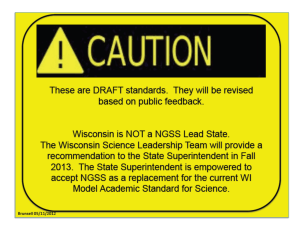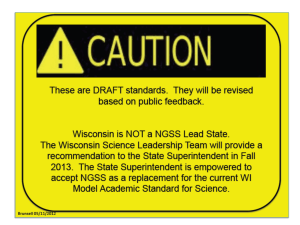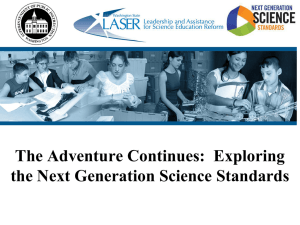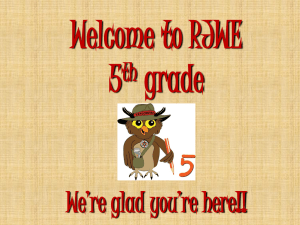Word - Next Generation Science Standards
advertisement
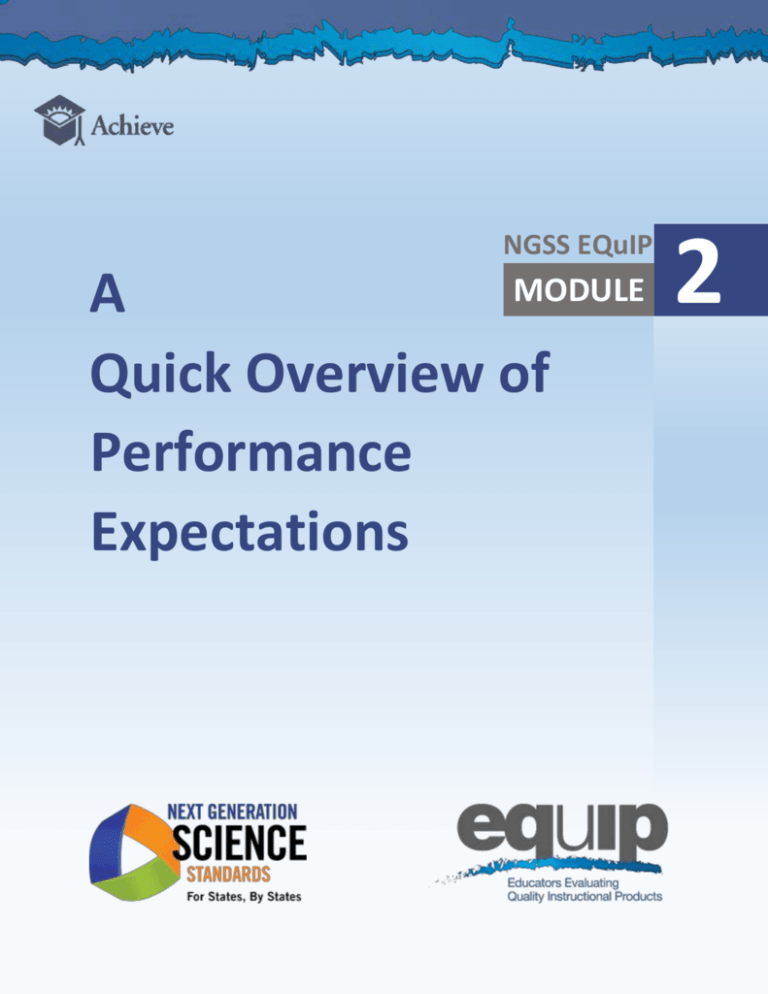
NGSS EQuIP MODULE A Quick Overview of Performance Expectations 2 Module 2: A Quick Overview of Performance Expectations This module provides a brief background on the performance expectations of the NGSS but should not be considered a thorough review of the NGSS. Participants should have an understanding of the Framework for K–12 Science Education and the NGSS before engaging in this professional learning. While this module does provide a brief background, ideally participants will not need to spend much time on it since they should already have an understanding of the Framework and the NGSS. If Module 2 is skipped or given to participants prior to the meeting, it may still be appropriate to emphasize some of the ideas in this module, such as the talking points identified with exclamation marks, throughout the professional learning. Materials Needed 1. Module 2 PowerPoint slides or slides 20–27 of the full PowerPoint 2. Handout 2: Module 2, Slide 25, “Format of Performance Expectations” (1 page, preferably color copies) 3. Handout 3: Module 2, Slide 27, “How to Read the NGSS” (3 pages, preferably color copies) MODULE 2: A Quick Overview of the Performance Expectations 23 Introduction to Module 2 Slide 20 Talking Points By the conclusion of this module, all participants should be able to respond confidently to the following questions: o What are the component parts of a performance expectation? o What are the implications of the three dimensions in the performance expectations for learning in the science classroom? Having a thorough conceptual understanding of performance expectations and their implications for teaching and learning NGSS is exceedingly important when using the EQuIP Rubric to examine and evaluate NGSS learning materials and resources. Defining and Explaining Performance Expectations Slide 21 MODULE 2: A Quick Overview of the Performance Expectations 24 Talking Points Essentially, a performance expectation states what students should be able to do in order to demonstrate understanding of the three dimensions. Performance expectations, however, go beyond the knowledge, skills, and understandings generally seen in previous standards documents. NGSS performance expectations require students to demonstrate conceptual understanding by applying the knowledge and understanding inherent in a standard. In addition, performance expectations require students to transfer knowledge and understanding to new or somewhat different situations. Slide 22 Talking Points ! Performance expectations are not learning tasks or instructional strategies. They are statements of what students should be able to do after instruction. Multiple lessons and/or multiple units of instruction experienced over time may be required for students to acquire the conceptual understanding needed to demonstrate mastery of standards via the performance expectations. In addition, as represented in this slide, student learning and the performance expectations that demonstrate this learning will build as students move through the grades. MODULE 2: A Quick Overview of the Performance Expectations 25 Slide 23 Talking Points ! The Framework takes the position that a scientifically literate person understands and is able to apply all of the core ideas in each of the major science disciplines in the Framework, so all students should be held accountable for demonstrating their achievement of all performance expectations. This is especially important in high school where traditionally students may have taken courses in some but not all science disciplines. Consequently, the disciplinary core ideas included in the performance expectations are limited to only those core ideas listed in the Framework. Performance expectations allow for an emphasis on coherence within lessons and units and across the years and grade levels — it’s all about learning progressions. When students demonstrate achievement via performance expectations, we can no longer say, “Students didn’t get it last year, so they can’t possibly get it this year.” Overall, it’s about what the students are doing and not what the teachers have done. The performance expectations should not, however, limit the curriculum. Students interested in pursuing science further via more advanced coursework or through additional concepts of interest and relevance to the student and/or the community should have the opportunity to do so. MODULE 2: A Quick Overview of the Performance Expectations 26 How to Read a Performance Expectation Slide 24 Talking Points We’re going to look now at the foundation boxes of the performance expectation, but it’s important to keep in mind that these foundation boxes are not the assessed piece of the performance expectation. The threedimensional performance expectation overall is what is to be assessed. Irrespective of grade level or discipline of science, every performance expectation has the following three parts: o The statement of the actual performance expected; o The foundations for this performance or, in other words, the practices, disciplinary core ideas and crosscutting concepts that constitute this performance (again, it’s important to note that students are not assessed on the foundation boxes or on a single dimension individually); and o The connections to other science disciplines, to other grades or grade bands, and to CCSS in ELA/literacy and mathematics, which contribute to coherence and will be addressed in a later module. Note to facilitator: In order to complete specific learning tasks, participants will need Handout 2, Module 2, Slide 25, “Format of Performance Expectations,” which is displayed on this slide. Slide 25 MODULE 2: A Quick Overview of the Performance Expectations 27 Talking Points ! Now take a look at an actual performance expectation. Performance expectations may be viewed either by topic or by core idea. The specific example on this slide is grouped by core idea. As noted in the top row [Note to facilitator: click for animation.], this performance expectation is MS-LS2-5 — Middle School, Life Science Core Idea 2 (Ecosystems: Interactions, Energy and Dynamics), Performance Expectation 5. This notation is the same regardless of whether the performance expectations are viewed by topic or core idea. The actual performance expectation appears in the second row following “Students who demonstrate understanding can...” [Note to facilitator: click for animation.] The performance expectation is sometimes followed by a clarification statement and/or assessment boundary, which appear in red [Note to facilitator: click for animation.]. Here the clarification statement elaborates on what is meant by properties that could be predicted from patterns, and the assessment boundary provides specific information regarding what this performance expectation does not include for large-scale assessment. It should be noted that while assessment boundaries do limit assessment, they do not necessarily limit instruction. While the performance expectations can stand alone, a more coherent and complete view the standards can be seen when the performance expectations are viewed in tandem with the contents of the foundation boxes that lie just below the performance expectations. These blue, orange, and green foundation boxes delineate the three dimensions. That is, the practices [Note to facilitator: click for animation.], disciplinary core ideas [Note to facilitator: click for animation.] and crosscutting concepts [Note to facilitator: click for animation.] derived from the Framework that were used to construct this set of performance expectations. Finally, [Note to facilitator: click for animation.] connections are made to other disciplinary core ideas within this grade band, across grade bands, and to the CCSS in ELA and mathematics. Now, individually circle the words or phrases in the performance expectation that directly relate to the specific practice(s), core idea(s), and crosscutting concept(s) listed in the blue, orange and green boxes. Next, draw arrows to connect your circled words and phrases directly to the specific practice, core idea and crosscutting concept in the colored boxes. When finished, share and compare at your table. What general statement about performance expectations can you make as a result of the connections you just made? [Note to facilitator: Allow approximately five minutes for this task, and then have one or two tables to share. Elicit responses that show how the performance expectation is three-dimensional.] MODULE 2: A Quick Overview of the Performance Expectations 28 Note to facilitator: Please give credit for the photo on this slide to http://blogs.wsj.com/photojournal/2009/ 07/10/pictures-of-the-day-216/. Slide 26 Talking Points ! Remember, instruction, over time, builds the structures — the practices, disciplinary core ideas and crosscutting concepts — that students need to meet the performance expectations. It also is important to note that while the practices, disciplinary core ideas and crosscutting concepts specified in the performance expectations describe how students are asked to demonstrate understanding at the end of instruction, this does not limit what practices can or should be used in instruction. For example, if a performance expectation calls for students to construct an explanation, this merely indicates the assessment expectation for students. In the classroom, a teacher also will have students engage in additional practices such as asking questions and analyzing data. Concluding Slide for Module 2 Note to facilitator: Refer participants to Handout 3, Module 2, Slide 27, “How to Read the NGSS,” where they will find more information on this topic. Slide 27 MODULE 2: A Quick Overview of the Performance Expectations 29 Talking Points At your tables, quickly think about how you would respond to the two questions for Module 2 to ensure your understanding before going on to Module 3. Identify and be prepared to ask any questions you still have about performance expectations. [Note to facilitator: Allow approximately five minutes, and then address any remaining questions.] For more information about the performance expectations, refer to the handout for Module 2, Slide 27, “How to Read the NGSS.” MODULE 2: A Quick Overview of the Performance Expectations 30



